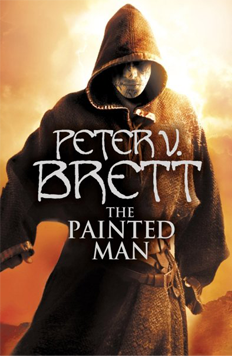In this world, demons come out every night, rising through the ground from the core of the earth, and they will rip you to pieces and eat your bits unless you hide behind protective wards.
The setting is a cross between the mock-medieval universe familiar from many fantasy novels, and a study of backward, closed communities. Hardly anybody travels, because the demons eat you if you stay out at night, unless you have a ‘portable circle’, made of pieces of wood or ceramic with wards on them. But you have to know how to lay out this circle appropriately so that the demons can’t find any weakness in the imaginary protective net through which they could barge in and gleefully nom you. The people who travel are called Messengers, because they carry messages, as well as everything else that ever travels. They are usually accompanied by a ‘Jongleur’, a fool in motley, who plays music and tells stories, and constitutes the only manifestation of culture in the outlying hamlets. The central premise of the plot is that humankind is going to be eradicated by demons because the knowledge of old has been lost, and people have become uneducated and unable to communicate with each other. Also, they are crippled by fear of the demons and a lack of creativity when it comes to dealing with them.
Our hero is a man named Arlen. Similar to The Name of the Wind, the story begins with Arlen as a boy, describing how he is made exceptional by a traumatic experience: his mother is mauled by a demon, his father doesn’t try to save her, and then daddy goes off and marries a younger woman. Arlen takes this personally, so he runs away from home. Conveniently, he has a unique talent for painting wards, so he survives by scraping wards into the mud. (Wards are a bit like maths or language, in that they must be lined up in some sort of order for them to make a protective net, and different combinations have different degrees of effectiveness, therefore some people are better at ‘warding’ than others.) Unfortunately, he is a young hothead, so he baits the demons that are trying to get into his circle, and ends up getting scratched by a rather large one, and then chopping off its arm. The demon takes that extremely personally (as one would), and proceeds to pursue Arlen relentlessly for the rest of the novel. Arlen, meanwhile, gets himself attached to a Messenger and a Warder, and becomes an extremely accomplished, if mentally unstable, young individual.
In addition to Arlen, there are two more pov characters in The Painted Man: Leesha, who accidentally becomes the world’s best ‘herb gatherer’ (i.e. healer), and Rojer, improbably the world’s best Jongleur, who had part of his right hand eaten by a demon when he was little. These two are the sidekicks Arlen requires in order to save the world, but as this is a trilogy, don’t hold your breath. By the end of book one, the central characters have all more-or-less met, but that’s about it.
The plot of the novel is propelled by travel, which is perhaps not surprising, as the characters are unique precisely because they travel. Leesha goes to a city far from home to be apprenticed to a master-healer (and to avoid trouble at home), Rojer travels the countryside as a Jongleur spreading songs and stories and sleeping with other people’s wives (he is young but precocious) and Arlen crosses the desert for an Orientalist sojourn in distant Krassia, where the men fight the demons every night, and he learns about bravery and demon-fighting strategies. By the end of the novel, our heroes’ paths have converged, and there is a satisfying final battle which sets things up nicely for the sequel, The Desert Spear.
Overall, it is a fun, absorbing read, with strong characters and a good sense of poetic justice. There are a few graphic sex scenes, and the ocassional instance of gruesome violence and blood all over the place, but nothing too strong for my delicate constitution, so you'll probably be alright. I thouroughly recommend it.

No comments:
Post a Comment